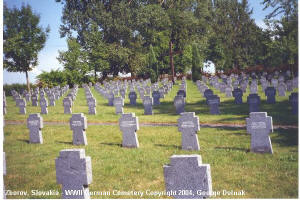| Slovakia Genealogy Research Strategies | ||||||
| Home | Strategy | Place Names | Churches | Census | History | Culture |
| TOOLBOX | Contents | Settlements | Maps | FHL Resources | Military | Correspondence |
| Library | Search | Dukla Pass | ||||
Post-Dukla 1944 Soviet Offensive Operations
in Eastern Slovakia
Military History - Northeast Slovakia | Battle of Dukla Pass |
General Maps | WWII Battle Maps | 1944 Soviet Battle Maps - Czechoslovakia
German Cemetery at Zborov
Following the defeat of the Nazi troops at Dukla the Soviet/Czechoslovak troops split into two paths in mid-November 1944. The first, toward Svidnik and the second, taking a more southeasterly path following the southern exposes of the Carpathian mountain. This effectively served as a "pincer", enveloping and trapping German troops remaining in the mountains from the Dukla pass southward toward Snina.
While the pass was being taken on 6 October, other Soviet troops attacked the Carpathian mountain ridge from Nova Sedlica to Runina and northward. According to local testimony, fighting in this region persisted for about two weeks. (1) The troops first broke through this region at Runina on 7 October, while Nova Sedlica was taken on 16 October. Zboj Villagers fled to the woods and lived in hand-dug holes until the fighting ceased. (1) Once across the ridge, the troops appeared to meet German resistance until 26 October. In a coordinated offensive, the Soviet troops then proceeded southward from Runina and Nova Sedlica towards the Ulicska valley river. These troops met up with other Soviet divisions advancing from the east, from the area of Velky Berezna, and had taken Uzhorod on 26 October.
While Kalinov (slightly southeast of Dukla) was the
 first village to be taken by the Soviets (21 September), it appears to have been held in isolation until after the Dukla breakthrough. Kalinov fighting was direct by General Koldubov of the 128th division Soviet Army. Koldubov later became a Hero of the Soviet Union after his victories near Ostrava. Also participating was the 3rd Artillery Corps of the Soviet Army.
first village to be taken by the Soviets (21 September), it appears to have been held in isolation until after the Dukla breakthrough. Kalinov fighting was direct by General Koldubov of the 128th division Soviet Army. Koldubov later became a Hero of the Soviet Union after his victories near Ostrava. Also participating was the 3rd Artillery Corps of the Soviet Army.
After the Dukla breakthrough, troops moved rapidly southward in early November. The Soviet Army's Third Mountain Division (under the direction of A. J. Vedenin) moved south taking Certizine, Medzilaborce, Krasny Brod, arriving in Humenne on 25 November. Concurrently, the First Czechoslovak Volunteer Army (Major General A. A. Grecko) also left Certizine and Medzilaborce but then followed the southerly Carpathian mountain ridge foothills through Cabalovce, Svetlice, Hostovice, Pcoline, reaching Snina.
Snina - Major General Grecko
Another branch of the Third Army crossed the border at Ruske, then fought for the liberation of Snina, afterwards proceeding on to join up at Humenne, then to Dargov and Kosiče. This culminated in a several day fight in the triangular region of Stakcin, Snina and Kolonica. Snina was taken on 25 November. The Ulic valley liberation occurred a day later, suggesting that the Runina-Nová Sedlica stalemate may have been broken when German troops became trapped between north and south forces.
The 1st Volunteers then continued southward, following the Hungary-Slovak 1939 border, through Remetske Hamre to Sobrance, Vysne Revista and Baltna Polianka. The Volunteers then moved westward to Michalovce, which had been liberated on 26 November.
It should be noted that as the German troops retreated, the Germans attempted to leave nothing of value that the enemy might take advantage with. For the most part, they were in such a hurry to leave that they had time to disable remaining equipment. (5) It was at first thought that the Germans torches buildings as they retreated. This was not the case, as it would have allowed the Soviet and Czechoslovak Armies to detect German movement. For the most part, structures that burned were collateral damage resulting from artillery fire and other fighting. After the war, German prisoners of war were conscripted to rebuild village homes for several months. (1)
It is a miracle that a majority of the wooden churches survived. John Kulhan indicated that the Soviet-provided maps had all of the churches clearly marked. They were under orders to avoid destruction of these buildings.
See 1944 Soviet Battle Maps for movement detail.
See History for a detailed village liberation timeline.
References and Resources
(1) - Personal Interview with Helena Tarkulic'ova', 2001, B. Tarkulich
(2) - "The Great March of Liberation", Konev, Zakharov, Zheltov, Grechko, Sharokhin, Telegin, Progress Publishers, USSR, 1972
(3) - "Dukla", Vydavatelstvo Osveta, Vychodoslovenske Vydavatelstvo & Dukla Museum in Svidnik, 1979, CSSR
(4) - "Below Snina Rock", 1964, Vladimír Slimák
(5) - Personal Interview with John Kulhan, Infantry, 1st Brigade, 1st CSK Army, Nov. 2005, Bill Tarkulich
(6) John Kulhan, Infantry, 1st Czechoslovak Army in Exile - Newspaper Article
Links to off-site webs will open in a new window. Please disable your pop-up stopper.
Last Update: 15 November 2020 Copyright © 2003-2021, Bill Tarkulich
